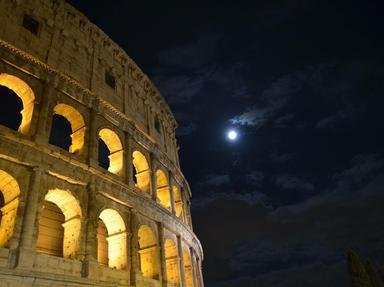Quiz Answer Key and Fun Facts
1. In 133 BC, Tiberius became a tribune of the plebs and began his agricultural legislation program. However, the methods he used to pass many of his controversial laws angered the nobility. Who was the tribune the Optimates used to oppose this legislation?
2. In 122 BC, Tiberius' brother, Gaius Gracchus, revived his brother's revolutionary legislation. Part of it was the founding of colonies, one of which was to be founded on the site of Carthage. What was the name of that colony?
3. Gaius Gracchus held the city of Rome under such undisputed control that for a year he was considered the uncrowned king of Rome. Who was the senator who finally defeated Gaius?
4. In 107 BC, the popular assembly appointed the consul, Gaius Marius, to act against Jugurtha thus usurping the Senate's supremacy in foreign affairs. Who was the commander that Marius replaced?
5. In 113 BC, the Romans had their first encounter with the Cimbri and the Teutones. This was the first in a long line of engagements. After the battle of Arausio, where eighty thousand Roman lives were lost, the people appointed Marius to the command against the Germanic tribes. He defeated them in two battles. The first was at Aquae Sextiae. What was the name of the other?
6. After the death of the tribune Livius Drusus, son of the tribune that had opposed Gracchus, and his Italian enfranchisement bill, the Senate sent a commission to travel through Italy and visit the disaffected towns. The Roman magistrate in one of these towns mistreated the residents thus provoking in the complete massacre of all Romans there. What was the name of this town?
7. In 88 BC, Gaius Marius and Cornelius Cinna took control of Rome. During this time a young Julius Caesar was named to what special priesthood?
8. When Sulla finished with the First Mithridatic War, he returned to Italy and captured Rome from Cinna and Carbo. Sulla then had the Senate name him dictator. After this, he began to reconstruct the Roman constitution. One major part of this reconstruction was the debilitating of the tribune of the plebs. Which one was not one of his measures to shackle the tribunes?
9. In 78 BC, the consul Macus Aemilius Lepidus and the praetor Marcus Junius Brutus rebelled against the reconstructed government of Sulla. Pompey and Lutatius Catulus swiftly crushed the rebellion in 77 BC in two battles. What was the name of the second battle where Lepidus was defeated?
10. The last of the Marians to be defeated was Quintus Sertorius, the governor of Spain. The Pontifex Maximus, Metellus Pius, was sent to dislodge him from his stronghold. In 77 BC, the fugitives of Lepidus' failed rebellion joined hands with Sertorius. The war was brought to an abrupt end when the leader of the fugitive forces murdered Sertorius in 72 BC. What was his name?
Source: Author
bulk
This quiz was reviewed by FunTrivia editor
bloomsby before going online.
Any errors found in FunTrivia content are routinely corrected through our feedback system.

